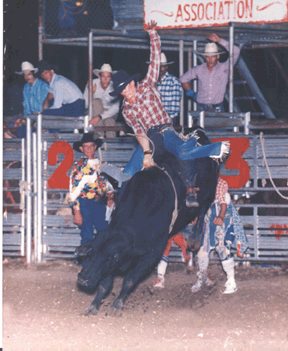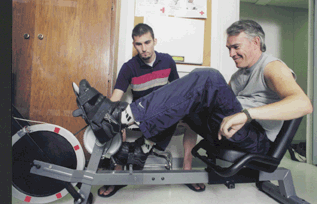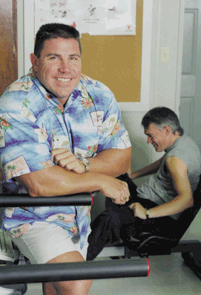|
Riding it out
There is no sense sitting around waiting
for a cure for paralysis, says kinesiology professor Darryn Willoughby.
He's helping those with spinal cord injuries to possibly walk again -- and
they get a workout in the process.
By Rick Waters '95

 6:15
p.m., July 9, 1995. Blaine Manigold vividly remembers that exact minute. 6:15
p.m., July 9, 1995. Blaine Manigold vividly remembers that exact minute.
Bailing
off the side of a 2,000-pound bull after a successful ride, Manigold felt
a shot of pain in his back as a steer hoof ramrodded the hard shell of
a protective vest between his shoulder blades. The force snapped his neck
backward then forward, dislodging his fifth vertebra.
"No, don't
touch me," he cried from the ground as fellow bull riders rushed to help.
"Don't even take my boots off."
Manigold
had ridden bulls for 15 years and knew the dangers. Instantly, the realization
struck -- he was paralyzed.
Until then,
his life had been about motion. As a cowboy, he lived it. As an exercise
and physiology major, he studied it. He knew more than anyone that motion
is what the body craves from one moment to the next, every tenth of a
second of the day.
"Your body
needs movement for optimum health. The body wants to move whether it is
paralyzed or not," Manigold, a TCU kinesiology graduate student, commented
almost seven years later.
His stubborn
streak remains alive. The self-professed hardhead wakes each morning before
the help arrives, sits up, rolls over and struggles to get out of bed
alone. It is his routine.
But what
he wants is exercise. The problem is finding modified training equipment,
which is in short supply. In his search for movement, he also battles
conventional medical thinking, which tells him just to sit and wait for
a cure.
That cure
may be some time off, but Manigold refuses to waste away until scientists
achieve a breakthrough. He is finding a way to move as a subject in the
groundbreaking exercise research of TCU kinesiology professor Darryn Willoughby
and his Tarleton State University colleague Joe Priest.
 It
started in Stephenville in 1992 when an engineer/inventor named Russell
Jennings developed a type of recumbent bicycle for individuals with neuromuscular
dysfunction. It allowed them to strap their feet in and have a teammate
move the pedals. Some could even push their own legs with their hands. It
started in Stephenville in 1992 when an engineer/inventor named Russell
Jennings developed a type of recumbent bicycle for individuals with neuromuscular
dysfunction. It allowed them to strap their feet in and have a teammate
move the pedals. Some could even push their own legs with their hands.
Jennings
saw it as a way to help the disabled, who are at higher risk for cardiovascular
and pulmonary disease due to a decrease in physical activity. What Jennings
never understood, however, is what effect his invention might have in
the muscles.
He showed
his bike to scientists at Tarleton's Laboratory for Wellness and Motor
Behavior, where Priest thought it would be good to use in exercise experiments
that study oxygen intake and electromyography, or electrical activity
in the muscles. After a trial run, Priest's initial findings indicated
something, indeed, was happening.
To study
it further, Priest called on Willoughby, a Tarleton graduate and researcher
at the University of Southern Maine at the time. Willoughby took muscle
biopsies of the subjects' legs and concluded that some of the muscle fibers,
after training, were not only retaining protein but also enlarging.
"At the time,
we were saying, ÔHow can this be happening?'" Willoughby said.
Their research
was unique in that the subjects were not receiving stimulation. Previous
research with the spinal cord injured had involved attaching electrodes
to subjects' hamstrings and thighs and applying electrical activity to
cause contractions in the muscles to make their legs move. In Willoughby
and Priest's study, though, the cyclists were doing all the work themselves
by using their torso and arms to assist their legs in pedaling the bike.
Next, Willoughby
and Priest added more subjects who pedaled more frequently and for a longer
period -- 12 weeks. With that research, they analyzed biochemical factors
and discovered accelerated activity within the genes of the muscle, suggesting
that disabled persons, if they continued the workout over time, could
maintain some muscle mass or significantly slow the rate of muscle wasting
and loss of bone density.
Ultimately,
this type of exercise may help prepare the disabled to walk again if neurological
scientists find a way to regenerate central nervous system cells and repair
spinal cord lesions.
"I firmly
believe that it is only a matter of time," Willoughby said. "So we are
training these people for the future. We are attempting to help the spinal
cord injured maintain as much of the muscle mass in their paralyzed legs
as possible."
 Willoughby
admits that some people say he's wasting his time on individuals who can't
walk, but there are too many other benefits to stop trying. "Scientists
are working aggressively for a cure and that's good," he said, "but
why should we write these individuals off now?" Willoughby
admits that some people say he's wasting his time on individuals who can't
walk, but there are too many other benefits to stop trying. "Scientists
are working aggressively for a cure and that's good," he said, "but
why should we write these individuals off now?"
Heart disease,
type II diabetes and obesity are major contributing factors to mortality
in the spinal cord injured, but by doing preventive maintenance now, they
may be able to enjoy a longer and higher quality of life.
In the meantime,
Manigold and other subjects reap the benefits of old-fashioned exercise -- a
cardiovascular workout, reduction in muscle spasms and increases in pulmonary
function.
"I don't
take any [antispasticity] medicine at all anymore," he said. "Your muscles
get so tired it takes the spasms right out of them."
Anecdotally,
some subjects reported their bladder infections and pressure sores from
constant sitting went away.
Willoughby
has since joined Joel Mitchell in TCU's kinesiology department to build
their own bike. They have started a longer-term program with more subjects
and tighter controls to take a closer look at what is happening in the
muscles and what effect the exercise has on the immune system.
Willoughby
is convinced that there is a psychological effect, as well.
"I've watched
people come in here and ride these bikes, and after a time the look on
their faces speaks volumes," he said. "Their psychological output and
their emotional state increase dramatically. Their self-esteem improves."
Willoughby,
Mitchell and their research assistants have also found that spinal cord
injured people can eclipse projected fitness levels. For example, Manigold
said 75 percent of his predicted target heart rate is 136 beats per minute,
but he can consistently reach the mid-160s.
Manigold
hopes his physical achievements and TCU's continued research can change
the thinking among those doctors who see little hope for the disabled
to walk again. Instead of taking drastic measures, such as removing leg
tendons and surgically grafting them into weakened wrists of disabled
patients, Manigold would like the medical profession to wait and assess
the cumulative effect of cycling exercise over a number of years.
Then doctors
can base future medical procedures and physical therapy on maintaining
muscle and bone instead of teaching people how to cope with lost limbs.
"If we can
use this as a way -- if nothing else, to improve their quality of life
and outlook on life -- that's pretty impactful," Willoughby said.
And maybe
the cure is a heartbeat away.
Contact Willoughby
at d.willoughby@tcu.edu

Top
|



